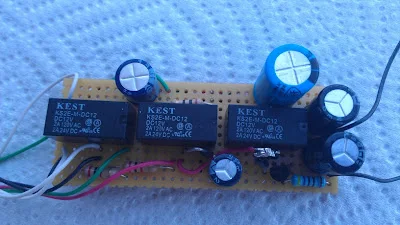Timer Garage Door Circuit
Because I’m old school, I wanted to build a Garage Door Closing circuit without relying on integrated configurations (555 timer etc) to keep it simplistic. The circuit closes the garage door after two minutes with C3 and four minutes with the addition of C2. The timer relay is surprisingly accurate (+/- five seconds). Another feature is to ensure that the garage door actually did close, such as if it’s stopped mid-operation by the user.
Description:
S3 (magnetic N.C.) is located at the garage door and activates the circuit when the garage door opens.
RL1 is the reset timer. It’s maintained in the “on” position for two minutes by C3 while the trigger capacitor, C4, is charged. RL2 is the conduit, directing C4 to either RL3 or R1 to ground when off. Purpose of R1 is to prevent arching across contacts and a fast discharge. RL3’s contacts are connected to the Garage Door’s Momentary Switch and is sustained “on” for a half second by C5.
When C3 discharges to the cutoff voltage of RL1, it turns off and resets. C4 charges C5, which turns on RL3 and initiates the garage door. Because C4 does not have the time to fully discharge, it should be at least three times the value of C5. If it does not close, RL1 in countdown mode will reset and open the door. When it resets again, the door will close.
Turning off the circuit, C1 maintains RL1 “on” slightly longer to ensure that RL2 is set to discharge C4 to R1. If this is not done and C4 is not discharged, the garage door will not open until it discharges naturally and falls below the trigger voltage for RL3. The circuit would be useless for several days.
Notes:
-Time delay of RL1 after reset drops 15 seconds because of the short charge time.
-To boost RL3 to a one-second delay, increase C5 to 1000uF.
-D2, D3, and D4 isolate the crucial sections of the circuit.
-Relays do not turn off at the same rate. I conducted a test by tripping the circuit on and off at a high rate and discovered the possibility of C4 turning on RL3. The addition of C1 solved this.
*Author: Roland Segers (speedmail-at-gmail.com)


Post a Comment for "Timer Garage Door Circuit"
Dont use outgoing links!